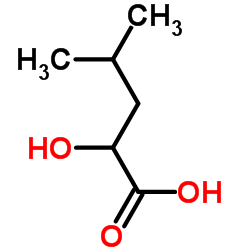2-hydroxy-4-methylvaleric acid

2-hydroxy-4-methylvaleric acid structure
|
Common Name | 2-hydroxy-4-methylvaleric acid | ||
|---|---|---|---|---|
| CAS Number | 498-36-2 | Molecular Weight | 132.16 | |
| Density | 1.1±0.1 g/cm3 | Boiling Point | 251.3±13.0 °C at 760 mmHg | |
| Molecular Formula | C6H12O3 | Melting Point | 78-80ºC | |
| MSDS | Chinese USA | Flash Point | 120.1±16.3 °C | |
|
Lipidomic profiling reveals significant alterations in lipid biochemistry in hypothyroid rat cerebellum and the therapeutic effects of Sini decoction.
J. Ethnopharmacol. 159 , 262-73, (2014) Hypothyroidism is known to be closely associated with lipid metabolism. Although our previous serum and urine metabonomics studies have provided some clues about the molecular mechanism of hypothyroidism at the metabolic level, the precise mechanism underlyin... |
|
|
Metabolic footprinting for investigation of antifungal properties of Lactobacillus paracasei.
Anal. Bioanal. Chem 408 , 83-96, (2016) Lactic acid bacteria with antifungal properties are applied for biopreservation of food. In order to further our understanding of their antifungal mechanism, there is an ongoing search for bioactive molecules. With a focus on the metabolites formed, bioassay-... |
|
|
Hydroxy acid metabolites of branched-chain amino acids in amniotic fluid.
Clin. Chim. Acta 140(2) , 157-66, (1984) A method is described in which ammonia chemical ionization gas chromatography-mass spectrometry was utilized in the selected ion monitoring mode to provide an accurate, selective approach to the quantification in amniotic fluid of a number of hydroxylated org... |
|
|
Comparative utilization of the alpha-keto and D- and L-alpha-hydroxy analogs of leucine, isoleucine and valine by chicks and rats.
J. Nutr. 112(10) , 1929-39, (1982) Several experiments were conducted to quantitatively evaluate the growth-promoting capacity of the isomers of the branched-chain amino acids (BCAA) and their alpha-hydroxy and alpha-keto analogs for the chick and rat. Basal chemically defined diets were formu... |
|
|
Studies of urinary organic acid profiles of a patient with dihydrolipoyl dehydrogenase deficiency.
Clin. Chim. Acta 133(2) , 133-40, (1983) Using gas chromatography-mass spectrometry (GC/MS), urinary organic acid profile studies were carried out on a patient with dihydrolipoyl dehydrogenase (E3) deficiency. Elevated levels of 2-hydroxyglutaric acid, 2-hydroxyisocaproic acid and 2-oxoisocaproic ac... |
|
|
[The growth of rats in renal compensatory adaptation in feeding with a supplemented diet of hydroxy-analogs of essential amino acids].
Z. Urol. Nephrol. 82(2) , 105-12, (1989) Rats were fed protein-restricted after unilateral nephrectomy (6.7% casein). Comparatively other animals were fed with experimental diets, at which 20% of the casein have been replaced by Ketosteril or a mixture of hydroxy acid. The constituents of this mixtu... |
|
|
Bioactivation mechanism of L-thiomorpholine-3-carboxylic acid.
Arch. Biochem. Biophys. 273(2) , 562-71, (1989) L-Thiomorpholine-3-carboxylic acid (L-TMC) is a cyclized analog of S-(2-chloroethyl)-L-cysteine, which is cytotoxic in vitro and nephrotoxic in vivo. To determine whether L-TMC may play a role in S-(2-chloroethyl)-L-cysteine-induced toxicity, the cytotoxicity... |
|
|
2-Hydroxyisocaproic acid (HICA): a new potential topical antibacterial agent.
Int. J. Antimicrob. Agents 39(6) , 539-40, (2012)
|
|
|
Severe illness caused by the products of bacterial metabolism in a child with a short gut.
Eur. J. Pediatr. 144(1) , 63-5, (1985) An 8-year-old boy with a short gut had six episodes of metabolic acidosis and neurological dysfunction over a 1 month period. The neurological features consisted of a depressed conscious state, confusion, aggressive behaviour, slurred speech and ataxia. The o... |
|
|
Urinary D-4-hydroxyphenyllactate, D-phenyllactate and D-2-hydroxyisocaproate, abnormalities of bacterial origin.
J. Inherit. Metab. Dis. 10(4) , 383-90, (1987) Analysis of urinary organic acids in patients admitted for screening for inborn errors of metabolism incidentally revealed the presence of abnormal amounts of 4-hydroxyphenyllactate (4-HPLA) and phenyllactate (PLA). These compounds are found in tyrosinaemia a... |